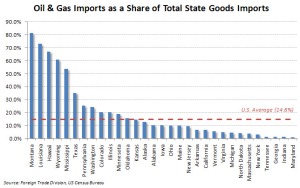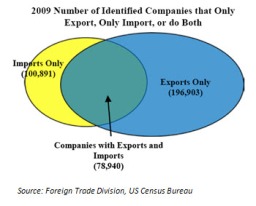According to FRBSS and calculations by the authors, Galina Hale and Bart Hobijn,
(with data from the Bureau of Economic Analysis, Bureau of Labor Statistics,
Census Bureau, and National Accounts Data), goods and services from China accounted for only 2.7% of U.S. personal consumption expenditures in 2010, of which less than half reflected the actual costs of Chinese imports.
The rest went to U.S. businesses and workers transporting, selling, and marketing goods carrying the "Made in China" label.
Although globalization is widely recognized these days, the U.S. economy actually remains relatively closed, says the report. The vast majority of goods and services sold in the United States is produced here. In 2010, imports were about 16% of U.S. GDP. Imports from China amounted to 2.5% of GDP.
Analysis from several sources addressed the following considerations:
- The fraction of U.S. consumer spending that goes for goods labeled "Made in China" and the fraction that is spent on goods "Made in the USA"
- The part of the cost of goods "Made in China" is actually due to the cost of these imports and the part of U.S. consumer spending that can be traced to the cost of goods imported from China, taking into account not only goods sold directly to consumers, but also goods used as inputs in intermediate stages of production in the United States.
Although globalization is widely recognized these days, the U.S. economy actually remains relatively closed. The vast majority of goods and services sold in the United States is produced here. In 2010, imports were about 16% of U.S. GDP. Imports from China amounted to 2.5% of GDP.
The table shows calculations of the import content of U.S. household consumption of goods and services. A total of 88.5% of U.S. consumer spending is on items made in the United States. This is largely because services, which make up about two-thirds of spending, are mainly produced locally. The market share of foreign goods is highest in durables, which include cars and electronics. Two-thirds of U.S. durables consumption goes for goods labeled "Made in the USA," while the other third goes for goods made abroad.
Chinese goods account for 2.7% of U.S. PCE, about one-quarter of the 11.5% foreign share. Chinese imported goods consist mainly of furniture and household equipment; other durables; and clothing and shoes. In the clothing and shoes category, 35.6% of U.S. consumer purchases in 2010 was of items with the "Made in China" label.
| Import Content of US Personal Consumption Expenditures (% of Expenditure share) |
|
Import Content
|
| Share Spent On |
Directly Sold to Final Demand
|
Total
|
| Category | Expenditure Share | Made in USA | Made in China | Total | Chinese Goods | Total | Chinese Goods |
| Total |
100%
|
88.5
|
2.7
|
7.3
|
1.2
|
13.9
|
1.9
|
| Less food and energy |
86.1
|
88.0
|
3.1
|
7.7
|
1.4
|
13.0
|
2.0
|
| Durables |
9.9
|
66.6
|
12.0
|
18.7
|
6.2
|
26.3
|
7.3
|
| Motor vehicles |
3.4
|
74.9
|
1.2
|
17.5
|
0.6
|
27.4
|
1.9
|
| Furniture/HH equip. |
4.7
|
59.6
|
20.0
|
21.4
|
10.6
|
27.8
|
11.6
|
| Other durables |
1.8
|
69.0
|
11.8
|
14.2
|
5.3
|
20.5
|
6.2
|
| Nondurables |
23.2
|
76.2
|
6.4
|
12.1
|
2.6
|
22.1
|
3.3
|
| Food |
8.0
|
90.8
|
0.4
|
5.2
|
0.2
|
13.9
|
1.1
|
| Clothing/shoes |
3.4
|
24.9
|
35.6
|
29.5
|
13.8
|
33.6
|
14.7
|
| Gasoline/other energy goods |
3.6
|
88.4
|
0.1
|
7.4
|
0.0
|
34.1
|
0.5
|
| Other nondurables |
8.4
|
77.7
|
3.1
|
13.8
|
1.4
|
20.1
|
2.0
|
| Source: Author calculations based on Bureau of Labor Statistics, Trade Statistics, Census Bureus and National Accounts Data, August 2011 |
The authors explain that if a pair of sneakers made in China costs $70 in the United States, not all of that retail price goes to the Chinese manufacturer. In fact, the bulk of the retail price pays for transportation of the sneakers in the United States, rent for the store where they are sold, profits for shareholders of the U.S. retailer, and the cost of marketing the sneakers. These costs include the salaries, wages, and benefits paid to the U.S. workers and managers who staff these operations.
The table shows that, of the 11.5% of U.S. consumer spending that goes for goods and services produced abroad, 7.3% reflects the cost of imports. The remaining 4.2% goes for U.S. transportation, wholesale, and retail activities. Thus, 36% of the price U.S. consumers pay for imported goods actually goes to U.S. companies and workers.
This U.S. fraction is much higher for imports from China, says the report. Whereas goods labeled "Made in China" make up 2.7% of U.S. consumer spending, only 1.2% actually reflects the cost of the imported goods. Thus, on average, of every dollar spent on an item labeled "Made in China," 55 cents go for services produced in the United States. In other words, the U.S. content of "Made in China" is about 55%.
When total import content is considered, 13.9% of U.S. consumer spending can be traced to the cost of imported goods and services. This is substantially higher than the 7.3%, which includes only final imported goods and services and leaves out imported intermediates. Imported oil, which makes up a large part of the production costs of the "gasoline, fuel oil, and other energy goods" and "transportation" categories, is the main contributor to this 6.6 percentage point difference.
China's 2011 inflation rate is close to 5%. If Chinese exporters were to pass through all their domestic inflation to the prices of goods they sell in the United States, the PCE price index (PCEPI) would only increase by 1.9% of this 5%, reflecting the Chinese share of U.S. consumer goods and services. That would equal a 0.1 percentage point increase in the PCEPI. The inflationary effects would be highest in the industries in which the share of Chinese imports is highest-clothing and shoes, and electronics. In fact, recent data show accelerating price increases for these goods compared with other goods.
However, it does not seem that so far Chinese exporters are fully passing through their domestic inflation. In May 2011, prices of Chinese imports only increased 2.8% from May 2010. This is partly because a large share of Chinese production costs consists of imports from other countries.
Xing and Detert (2010) demonstrate this by examining the production costs of an iPhone. In 2009, it cost about $179 in China to produce an iPhone, which sold in the United States for about $500. Thus, $179 of the U.S. retail cost consisted of Chinese imported content. However, only $6.50 was actually due to assembly costs in China. The other $172.50 reflected costs of parts produced in other countries, including $10.75 for parts made in the United States.
| Make Up of Personal Consumption Expenditures |
| Source | % of Total |
| Made in U.S. from US parts |
81.9%
|
| Made in U.S. from parts imported from other countries |
5.9
|
| Made in U.S. from parts imported from China |
0.7
|
| Final goods imported from other countries |
6.1
|
| Final goods imported from China |
1.2
|
| U.S. content of "Made In" other countries |
2.7
|
| U.S. content of "Made In China" |
1.5
|
| Source: Sources: Bureau of Economic Analysis, Bureau of Labor Statistics, Census Bureau, and authors' calculations |
Of the 2.7% of U.S. consumer purchases going to goods labeled "Made in China," only 1.2% actually represents China-produced content. If we take into account imported intermediate goods, about 13.9% of U.S. consumer spending is attributable to imports, including 1.9% imported from China, concludes the report.
For the complete report and findings, go to :
http://www.frbsf.org/publications/economics/letter/2011/el2011-25.html





